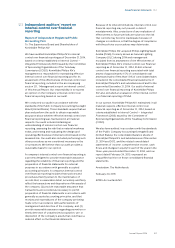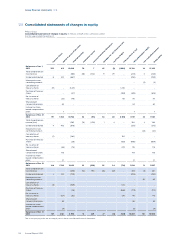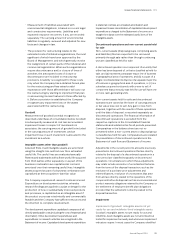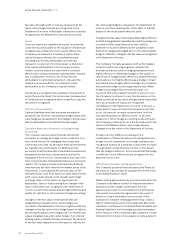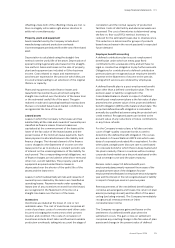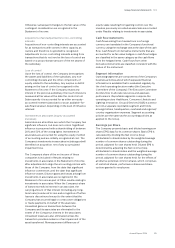Philips 2014 Annual Report Download - page 116
Download and view the complete annual report
Please find page 116 of the 2014 Philips annual report below. You can navigate through the pages in the report by either clicking on the pages listed below, or by using the keyword search tool below to find specific information within the annual report.
Group nancial statements 12.9
116 Annual Report 2014
Further judgment is applied when analyzing impairments
of goodwill and intangible assets not yet ready for use that
are performed annually and whenever a triggering event
has occurred to determine whether the carrying value
exceeds the recoverable amount. These analyses
generally are based on estimates of future cash ows.
Furthermore, the Company applies judgment when
actuarial assumptions are established to anticipate future
events and are used in calculating post-employment
benet expenses and liabilities. These factors include
assumptions with respect to interest rates, rates of
increase in health care costs, rates of future compensation
increases, turnover rates and life expectancy.
Changes in accounting policies
The accounting policies set out in this section have been
applied consistently for all periods presented in these
Consolidated financial statements, except for certain
voluntary accounting policy changes as explained below and
changes in accounting policies as a result of New Standards
and Interpretations (see next section).
Prior-period nancial statements have been
reclassied for two accounting policy changes applied
as of January 1, 2014:
• A reclassication of cost by function in the income
statement. Company-wide overhead and indirect
Business function costs will be brought more in line
with the actual activities performed in the markets.
This change has no net eect on Income from
operations.
Philips Group
Reclassication of cost by function1) in millions of EUR
2012 - 2013
2012 2013
Cost of sales 87 73
Selling expenses (53) (123)
Research and development
expenses (4) (44)
General and administrative
expenses (30) 94
Income from operations − −
1) Excludes the reclassication made for the combined businesses of
Lumileds and Automotive.
• A change in the presentation in the Statements of
cash ows. Up and until 2013 the cash ows related
to interest, tax and pensions were presented in a
table separate from the primary Statements of cash
ows. The presentation change results in the
separate presentation of the interest and tax cash
ows in cash ow from operating activities. The
pension cash ows are separately presented as part
of the pension disclosures. The presentation change
has no impact on the net cash ows from operating
activities nor the total net cash balance as these cash
ows previously used to be part of other aggregated
sub lines of the Statements of cash ows.
Prior-year information
The presentation of certain prior-year disclosures have
been adjusted to align with the current year disclosures.
New Standards and Interpretations
IFRS accounting standards adopted as from 2014
The Company has adopted the following new and
amended Standards and Interpretations as of January
1, 2014:
IFRIC 21 Levies
IFRIC 21 provides guidance on the accounting for
certain outows imposed on entities by governments in
accordance with laws and/or regulations (levies). The
Interpretation identies the obligating event for the
recognition of a liability as the activity that triggers the
payment of the levy in accordance with the relevant
legislation. This Interpretation does not have a material
impact on the nancial statements. The Company
early-adopted IFRIC 21, as endorsed by the EU, to align
with the IASB eective date of January 1, 2014.
Changes to other standards, following from
Amendments and the Annual Improvement Cycles, do
not have a material impact on the Company’s nancial
statements. In case of the absence of explicit transition
requirements for new accounting pronouncements, the
Company accounts for any change in accounting
policies retrospectively.
IFRS accounting standards adopted as from 2015
and onwards
A number of new standards and amendments to
existing standards have been published and are
mandatory for the Company beginning on or after
January 1, 2015 or later periods, and the Company has
not adopted them. Those which may be the most
relevant to the Company are set out below. Changes to
other standards, following from Amendments and the
Annual Improvement Cycles, do not have a material
impact on the Company’s nancial statements.
IFRS 9 Financial Instruments
IFRS 9 Financial Instruments brings together the
classication and measurement, impairment and hedge
accounting phases of the IASB’s project to replace IAS
39 Financial Instruments: Recognition and
Measurement. IFRS 9 adds a new expected loss
impairment model and limited amendments to
classication and measurement for nancial assets. The
impairment model is based on the concept of providing
for expected losses at inception of a contract, except in
the case of purchased or originated credit-impaired
nancial assets, where expected credit losses are
incorporated into the eective interest rate. The
Standard supersedes all previous versions of IFRS 9
and is eective for periods beginning on or after
January 1, 2018. The Company is currently assessing the
impact of the new Standard.



